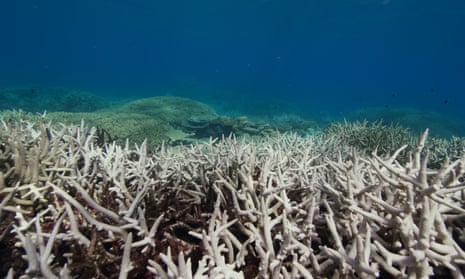Mass bleaching and coral death could be likely along the entire Great Barrier Reef this summer, according to a long-range forecast that coral experts say is “a wake-up call” for the Australian government.
The US National Oceanographic and Atmospheric Administration (Noaa) has forecast a 60% chance that the entire Great Barrier Reef will reach alert level one, which signals extreme heat stress and bleaching are likely.
The forecast period covers November 2018 to February 2019 and the risk extends to the southern Great Barrier Reef, which escaped the mass mortality seen in the middle and northern parts of the reef in 2016 and 2017.
“This is really the first warning bells going off that we are heading for an extraordinarily warm summer and there’s a very good chance that we’ll lose parts of the reef that we didn’t lose in the past couple of years,” said marine biologist Ove Hoegh-Guldberg, the director of the Global Change Institute at the University of Queensland. “These are not good predictions and this is a wake-up call.”
Hoegh-Guldberg said it was particularly worrying that the long-range forecasts were already showing high chances of bleaching and mortality before March, which is the main month of the year for bleaching events.
He said if the models proved accurate it would mean the entire Great Barrier Reef would be damaged by climate change and coral populations would trend towards very low levels, affecting the reef’s tourism and fishing industries and the employment they support.
“To really have the full picture we’re going to have to wait for those projections that cover the main part of bleaching season,” he said. “Given sea temperatures usually increase as we get towards March, this is probably conservative.”
The Intergovernmental Panel on Climate Change’s recent 1.5 degree report warned coral reefs were especially vulnerable to climate change.
At even 1.5 degrees of warming it estimated the planet would lose 80% of its coral reefs. At 2 degrees they would all be wiped out.
The government has backed coal power in defiance of the IPCC’s call for a phase-out by 2050.
But Hoegh-Guldberg said the projection and warning from the NOAA was “very consistent with what the IPCC 1.5 degree report told us.”
“It’s extremely important that politicians and our leaders stand up and make the changes we need to make so we don’t tread down an even more dangerous path,” he said.
The environment minister, Melissa Price, said “like many Australians, I deeply share concerns about the health and resilience of our world heritage listed-Great Barrier Reef.”
“We acknowledge that climate change has an impact on the reef,” she said. “That’s one of the reasons that Australia is working with other countries to tackle climate change through the Paris agreement, and we will deliver on the commitment to reduce emissions by 26-28 per cent of 2005 levels by 2030.”
Price said that of the $443m the government had given in a grant to the Great Barrier Reef Foundation, $100m would go towards reef restoration and coral recovery.
The most recent quarterly emissions data published by the government shows Australia’s emissions are increasing.
